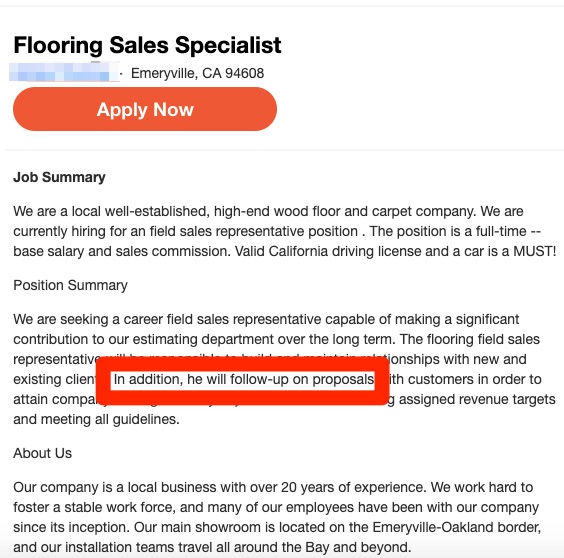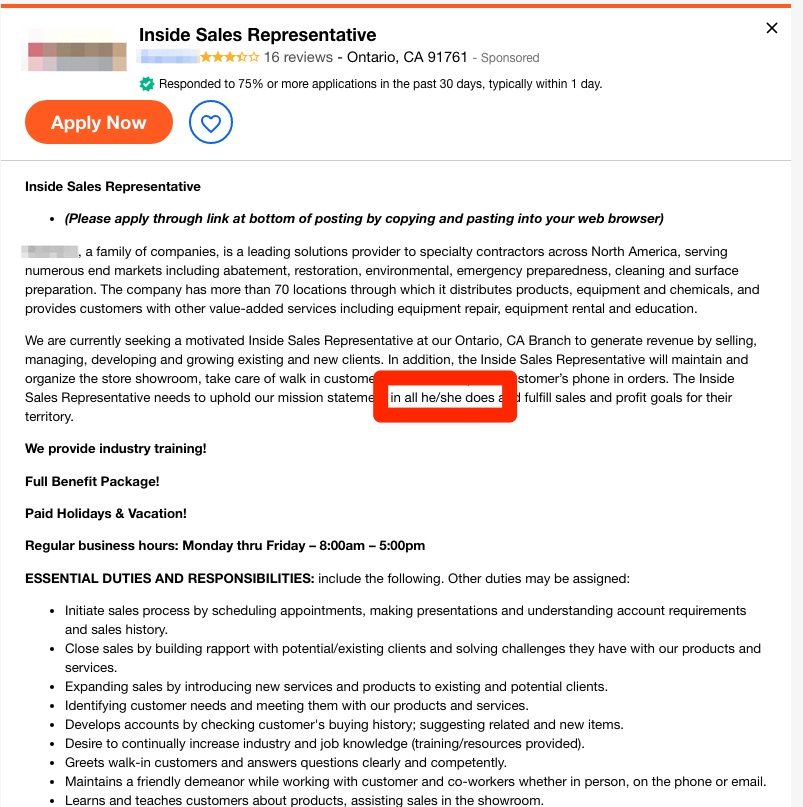- What’s the Difference Between a Job Description, Job Posting, and Job Ad - June 5, 2025
- Top 20+ Diversity Equity Inclusion Titles (with Descriptions) 2024 - October 18, 2024
- A List of Common Offensive (Exclusionary) Words Used in Job Descriptions (2024) - October 18, 2024
Using the wrong personal pronoun (he, she, his, her, etc.) can turn off groups of candidates.
Here are 3 examples of personal pronouns NOT to use along with synonyms I recommend.
Personal Pronoun/Job Description Tip #1: Don’t Refer to Candidate as “He”
Check out this first job ad below.

In the second paragraph it reads:
“In addition, he will follow-up on proposals with customers…”
he is a personal pronoun and excludes at least 3 groups of people:
- Women
- People who consider themselves transgender
- Non-women and non-transgender people sympathetic to the masculine bias of “he”
You should instead say:
“they will follow up with proposals”
or
“you will follow up with proposals”
Personal Pronoun/Job Description Tip #2: Don’t Refer to Candidates as “He/She”
Check out the job ad below. In the second paragraph it states:
“The Inside Sales Representative needs to uphold our mission statement in all he/she does…”

The writer is trying to be inclusive (“he/she” as a personal pronoun is an improvement versus saying just “he”).
But they are still excluding anyone who is or knows someone who is transgender (i.e. neither male or female).
They should instead say:
“The Inside Sales Representative needs to uphold our mission statement in all they do…”
Personal Pronoun/Job Description Tip #3: Don’t Refer to the Customer as “Mister”
Finally, there is one other personal pronoun pitfall. The candidate isn’t the only party mentioned in job descriptions.
Some job descriptions mention the customer.
Check out this line from the first paragraph of the ad above
“Also, we sell very ethically, so your commission isn’t based on up-selling Mr. Customer to a device/technology he doesn’t need.”

In this case, the writer of the job description should use “the customer” instead of “Mr. Customer” and the personal pronoun “they” instead of “he”.
For more tips on writing job descriptions, check out our How to Write a Job Description — Best Practices & Examples.
Why I wrote this?
Ongig’s Text Analyzer job description software makes your text inclusive to all candidates by avoiding all bias (gender, race, age, disabhility, etc.). Our proprietary algorithm/database of biased/exclusionary phrases flags the no-no words and gives you safe inclusive synonyms to swap right in! Please click the demo request button on this page to learn more.
